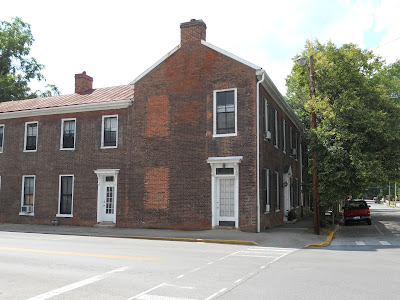Gen. Thomas Leonidas Crittenden (pictured above) was the second son of politician John J. Crittenden, and is often noted as being the most successful of his father's children. Thomas was born in Logan County, Kentucky, in 1816, but moved with the family to Frankfort as an infant.
Thomas was raised in the house pictured above, which is on the corner of West Main Street and Washington Street. He attended Frankfort Academy and later Centre College in Danville, where he learned with fellow Kentuckian - and future Confederate general and Secretary of War - John C. Breckinridge.
After a brief stint in the military in 1836-37, Thomas returned to Kentucky and worked for a brother-in-law in Louisville. While in the River City, he began studying law. He returned to Frankfort and married Catherine Lucy Todd, his step-sister. The couple had three children. Thomas's son, John Jordan, who was named after his grandfather the politician, was born in 1854, and died at the Battle of Little Big Horn with George Armstrong Custer.
In the 1840s, Thomas served as the commonwealth's attorney and participated on a committee that saw the remains of frontiersman Daniel Boone reinterred in the Frankfort Cemetery. When the Mexican War broke out, Thomas eagerly joined with other Kentuckians. He landed on the staff of his relative Gen. Zachary Taylor.
In the late 1840s, Thomas served in a consulate position in Great Britain, but in 1852, he resigned the position and came home to Frankfort and practiced law. In 1855, he purchased the house pictured above, but the family only lived there about four years.
Thomas's family connections and military experience in the Mexican War, and in the Kentucky militia, virtually ensured that he would participate in the Civil War. Being the son of a noted politician though did not necessarily determine which side he would end up fighting on. John J. Crittenden's oldest son and Thomas's older brother, George Bibb Crittenden, chose to serve the Confederacy. But Thomas decided to fight for the Union that his father so loved.
In the fall of 1861, Thomas was made brigadier general and commanded a division in the Army of Ohio at the Battle of Shiloh in April 1862. A promotion to major general saw his elevation to corps command. He was at the Battle of Perryville, Kentucky, but his corps was largely held in reserve. At the Battle of Stones River in December 1862, his corps, now in the Army of the Cumberland fought hard and Thomas received much deserved credit. He led the XXI Corps through the Tullahoma Campaign and fought at the Battle of Chickamauga, where he was censured for leaving the field of battle and relived of command. However, Thomas later was able to clear his name and returned to command.
In 1864 Thomas landed in the Army of the Potomac and led a division in part of the Overland Campaign. He participated it the Battle of Cold Harbor, but resigned soon thereafter.
After the war Thomas served briefly as the state treasurer back in Kentucky, but soon returned to the military and service in Arizona, and then Dakota Territory. He retired from the army in 1881 and settled in New York. He died in Staten Island in 1893. His body was brought back to Kentucky and buried in the Frankfort Cemetery near the Crittenden family plot.
Also buried near the patriarch politician is Thomas's brother George, the Confederate general. Like so many other families in Kentucky - famous and not so famous - the Crittendens were divided by the war. The Crittenden family, like the Clay and Breckinridge families, too, served as a microcosm of the state, which in turn served as a microcosm of the nation.
Senator, U.S. representative, governor, and U.S. attorney general, John J. Crittenden is buried near his sons on the high banks of the Kentucky River. His final resting place is in view of the current Kentucky state capitol building, which is barely visible in the left background of the above photograph.
Thomas Crittenden photograph courtesy of the Library of Congress.













No comments:
Post a Comment